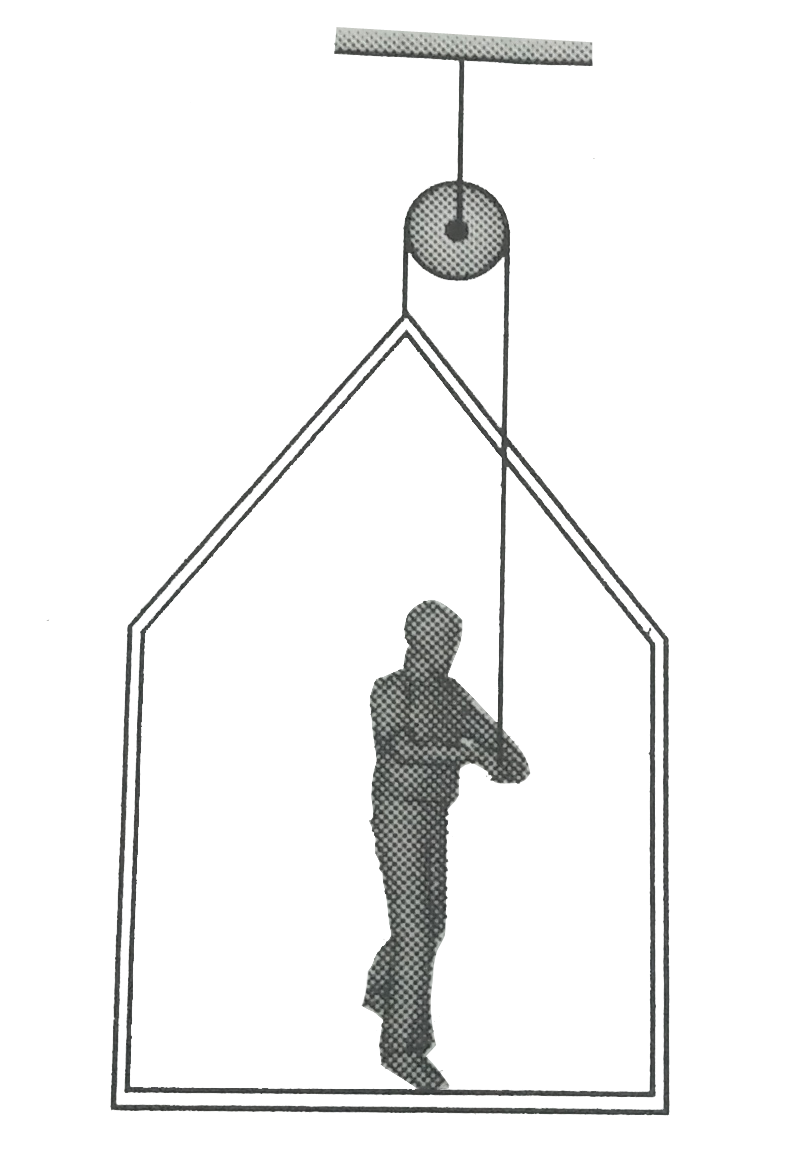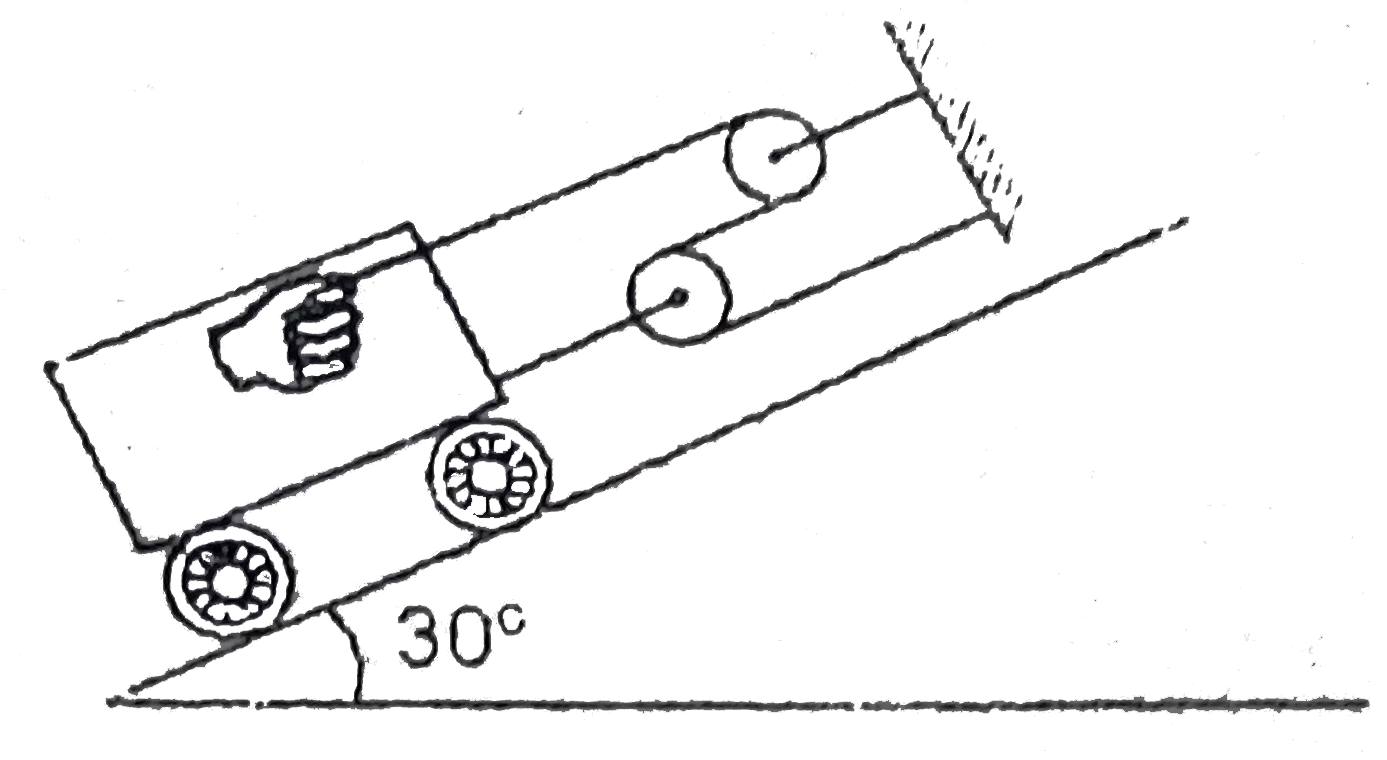A man of mass 85kg stands on a lift of mass 30kg When he pulls on the rope he exerts a force of 400N on the floor of the lift Calculate acceleration of the lift Given g=10m/s2 .
The correct Answer is:4.55m/s2 .
To solve the problem, we need to analyze the forces acting on the lift and the man. Here are the steps to calculate the acceleration of the lift:
Step 1: Identify the forces acting on the system
The forces acting on the man and the lift are:
1. The gravitational force acting on the man (weight) = Wm=mm⋅g=85kg⋅10m/s2=850N
2. The gravitational force acting on the lift (weight) = Wl=ml⋅g=30kg⋅10m/s2=300N
3. The force exerted by the man on the floor of the lift = F=400N
Step 2: Calculate the total weight of the system
The total weight of the system (man + lift) is given by:
Wtotal=Wm+Wl=850N+300N=1150N
Step 3: Determine the net force acting on the lift
When the man pulls on the rope, he exerts a force of 400N downward on the lift. The net force acting on the lift can be calculated as:
Fnet=F−Wtotal=400N−1150N=−750N
(Note: The negative sign indicates that the net force is directed downward.)
Step 4: Calculate the total mass of the system
The total mass of the system (man + lift) is:
mtotal=mm+ml=85kg+30kg=115kg
Step 5: Apply Newton's second law to find acceleration
According to Newton's second law, the net force is equal to the mass times acceleration:
Fnet=mtotal⋅a
Substituting the values we have:
−750N=115kg⋅a
Step 6: Solve for acceleration
Rearranging the equation to solve for a:
a=−750N115kg≈−6.52m/s2
Conclusion
The acceleration of the lift is approximately −6.52m/s2. The negative sign indicates that the lift is accelerating downward.
---
The forces acting on the man and the lift are:
1. The gravitational force acting on the man (weight) = Wm=mm⋅g=85kg⋅10m/s2=850N
2. The gravitational force acting on the lift (weight) = Wl=ml⋅g=30kg⋅10m/s2=300N
3. The force exerted by the man on the floor of the lift = F=400N
The total weight of the system (man + lift) is given by:
Wtotal=Wm+Wl=850N+300N=1150N
When the man pulls on the rope, he exerts a force of 400N downward on the lift. The net force acting on the lift can be calculated as:
Fnet=F−Wtotal=400N−1150N=−750N
(Note: The negative sign indicates that the net force is directed downward.)
The total mass of the system (man + lift) is:
mtotal=mm+ml=85kg+30kg=115kg
According to Newton's second law, the net force is equal to the mass times acceleration:
Fnet=mtotal⋅a
Substituting the values we have:
−750N=115kg⋅a
Rearranging the equation to solve for a:
a=−750N115kg≈−6.52m/s2
The acceleration of the lift is approximately −6.52m/s2. The negative sign indicates that the lift is accelerating downward.
Topper's Solved these Questions
- LAWS OF MOTIONBook:PRADEEPChapter:LAWS OF MOTIONExercise:JEE (Main and Advanced)/ Medical Entrance Special
Explore 93 Videos
- LAWS OF MOTIONBook:PRADEEPChapter:LAWS OF MOTIONExercise:Integer Type Questions
Explore 7 Videos
- LAWS OF MOTIONBook:PRADEEPChapter:LAWS OF MOTIONExercise:Fill in the blanks
Explore 20 Videos
- KINEMATICSBook:PRADEEPChapter:KINEMATICSExercise:1 NCERT Comprehension
Explore 4 Videos
- MATHEMATICAL TOOLSBook:PRADEEPChapter:MATHEMATICAL TOOLSExercise:Fill in the blanks
Explore 5 Videos
Similar Questions
A man with mass 85 kg stands on a platform with mass 25 kg. He pulls on the free end of a rope that runs over a pulley on the ceiling and has its other end fastened to the platform. The mass of the rope and the mass of the pulley can be neglected, and the pulley is frictionless. With what force does he have to pull so that he and the platform have an upward acceleration of 2.2ms2. (Take g=10ms2)
View SolutionA 75 kg man stands in a lift. What force does the floor does the floor exert on him when the elevator starts moving upwards with an acceleration of 2.0ms−2. ? Take g = 10ms−2.
View Solution
Knowledge Check
A man of mass 90 kg is standing in a lift whose cable broke suddenly. If thelift falls freely, the force exerted by the floor on the man is
A90NB180NCZer ND−90NA man of mass 70kg stands on a weighing scale in a lift which is moving:
Aupwards with a uniform speed of ms−1Bdownwards with a uniform acceleration of 5ms−2Cupwards with a uniform acceleration of ms−2. What would be the readings on the scale in each case?DWhat would be the reading if the lift mechanism falled and it hurted down freely under gravity?A young man of mass 60 kg stands on the floor of a lift which is accelerating downwards at 1m/s2 then the reaction of the floor of the lift on the man is (Take g=9.8m/s2).
A528 NB540 NC546NDnone
A lift is going up. The total mass of the lift and the passengers is 1500 kg . The variation in the speed of the lift is given by the graph shown in Fig . What will be the tension in the rope pulling the lift at (i) t=1s , (ii) t=6s (iii) t=11s ?
What is the height to which the lift takes the passengers ? During the course of entirs motion What is the average velocity and average acceleration of the lift ? Taken g=9.8m/s2
 .
.
View SolutionA man of mass m stands on a frame of mass M. He pulls on a light rope, which passes over a pulley. The other end of the rope is attached to the frame. For the system to be in equilibrium, what force must the man exert on the rope?

View SolutionA person of mass 60kg is inside a lift of mass 940kg and presses the button on control panel. The lift starts moving upword with an acceleration 1.0m/s2 . If g=10m/s2 , the tension in the supporting cable is.
View SolutionA person of mass 60 kg is inside a lift of mass 940 kg and presses the button on control panel. The lift starts moving upwards with an acceleration 1.0m/s2. If g=10ms−2, the tension in the supporting cable is
View SolutionA trolley is being up an incline plane by a man inside the trolley He applied a force of 500 N. If the mass of the man is 50 kg and trolley is 150 kg, then the acceleration of the trolley will be : (g=10m/s2)

View Solution
